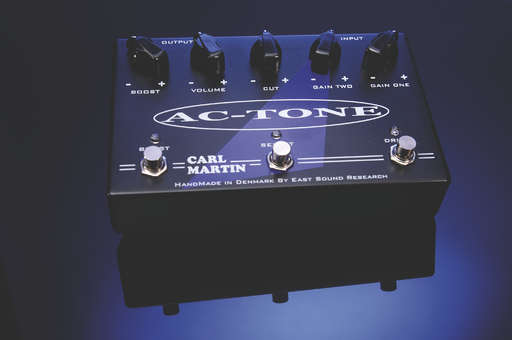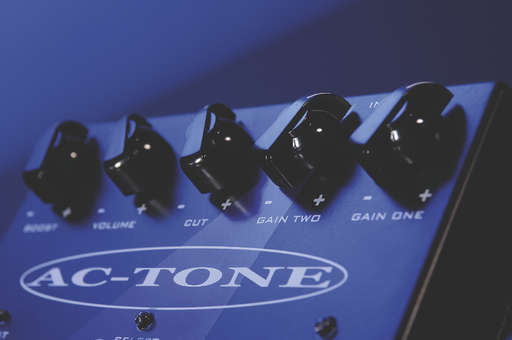MusicRadar Verdict
This is a great-sounding pedal.
Pros
- +
Very flexible. Good, focused tone.
Cons
- -
The on/off 'select' LED is slightly misleading.
MusicRadar's got your back



The AC-Tone takes a similar approach to Carl Martin's Plexitone pedal, but with a sonic nod of the head towards another classic British valve amp, the Vox AC30.
The layout of the AC-Tone is pretty much the same as that of the Plexitone. Working from the right hand side, the first footswitch turns the overdrive circuit on and off, while the second selects between the two independent drive channels.
The third footswitch turns the independent clean boost effect on and off; this can be used on its own or in combination with either of the drive channels.
All three pedals are clearly marked with bright blue LEDs. Once you understand the footswitch layout, the five controls are easy to figure out. Each of the two drive channels has its own gain control, and the master volume control adjusts the overall level of both channels.
The separate boost function isn't affected by the master volume, but it has its own independent gain control. Tone shaping for the drive channels is provided by a simple 'cut' control, familiar to anyone who has used a real AC30.
Apart from that, there's just one input and one output, and power is mains-only. In common with some of the other Carl Martin pedals, there's a welcome lack of a flimsy external power supply - just a good, sturdy mains cable.
Sounds
The ability of a pedal to sound like a particular amp is always going to be affected by the sound of the amp you plug it into.
Want all the hottest music and gear news, reviews, deals, features and more, direct to your inbox? Sign up here.
With that in mind, we weren't expecting to achieve a perfect likeness of an AC30, but wanted to see whether that amp's general characteristics could be imposed upon any amp.
Bearing in mind that the Plexitone produced several convincing versions of the 'Marshall sound', we were impressed to discover that the AC-Tone differs from that pedal exactly as we'd hoped.
The bass response is lighter and tighter and there's a fatter mid-range element to the sound, which can then be sharpened by careful use of the cut control.
Both drive channels produce the same sound (with the same cut setting) but the dual gain controls have plenty of range, so it's easy to set up clean, crunch and lead sounds, or whatever you need.
Further flexibility is added by the boost function, which can provide up to 20dB of additional boost. Think about it - you can add boost to your clean amp sound or to either of the two drive channels.
Including 'off', that's a total of six sounds - enough to cover most people's level-balancing requirements, we'd guess!
Used on its own the boost function can really kick some life into a clean valve amp, while in conjunction with the drive channels, there's enough gain on tap for most applications.
Combining high-gain and boost settings results in a pleasantly degraded fuzz tone… plenty of bite and aggression, but with a very smooth top end.
Furthermore, you don't have to use the AC-Tone to increase the volume of your basic amp sound. Unity gain seems to be around 20 per cent on the dual gain controls, so there's a modest amount of scope for dialling in lower-gain sounds if necessary.